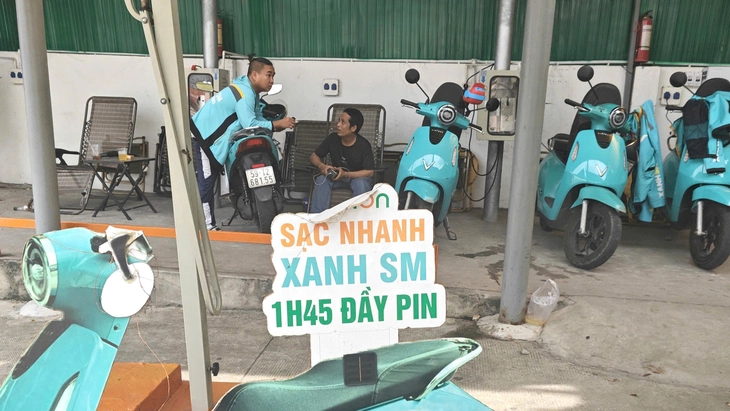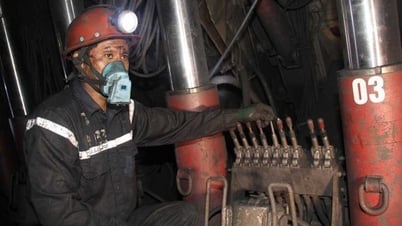
Drivers wait to charge their electric motorbikes at a coffee shop and charging station in Lai Thieu at noon on August 6 - Photo: CONG TRUNG
However, according to experts, for this model to continue to develop safely and sustainably, a clear legal framework, mandatory technical standards and a roadmap to support civil charging points to "transform" into licensed charging stations are needed.
Coffee shops and charging stations are popping up like mushrooms.
At around 12 noon on August 6, at a coffee shop located next to Lai Thieu toll station (HCMC), nearly a dozen technology car drivers were lying in hammocks, drinking water, and taking a nap while their cars were simultaneously plugged in to charge in front of the shop.
The chargers are mounted on the wall, and some places even take advantage of the billiard area to install 4-5 electric motorbike charging stations. "In this area, every shop now offers charging. When I cross the bridge on my way to work, my battery is almost empty, so I just stop by a shop, order a glass of iced tea, and charge it right away," said driver Dat (28 years old).
Please rate our products and services here.
Many shops without signs, with just a few electrical outlets, a few chargers, fans and instant noodles... are enough to operate a "mini charging station". This is a familiar image to many people in Ho Chi Minh City.
Since mid-2024, hundreds of similar charging points have sprung up, initially mainly in Binh Tri Dong A, An Nhon, Binh Thanh wards or along National Highways 1, 13..., later appearing in all coffee shops. Near delivery transfer stations, the number of "popular" charging points has also increased significantly in the past few months.
According to a survey by Tuoi Tre , some shops only charge slowly using regular power outlets for 20,000 - 25,000 VND/time, while many places have integrated a combo of water, charging and resting place (hammock or air-conditioned room) for 45,000 - 60,000 VND/time.
No big signs, no specialized equipment, just a few high-power sockets, a few chargers and free WiFi. The owner only needs to prepare a few hammocks, a few stone benches, and even a pot of instant noodles to serve drivers to have lunch while waiting for the battery to be full.
Ms. Phuong, the owner of a coffee shop in Linh Xuan ward, said that at first, a few drivers asked to charge their vehicles. Gradually, more drivers returned, so she connected three-phase electricity, installed more sockets, and bought fire protection equipment. Now, revenue from charging customers accounts for 70% of the shop's income. Every day, the shop welcomes about 10-25 cars to charge, the busiest times are noon and evening.
"With a fee of 20,000 - 60,000 VND/turn, this service brings stable income to many small businesses like us," said Ms. Phuong.
Not only coffee shops, some houses also take advantage of using the ground floor to open "electric vehicle charging services", with green cars coming in and out regularly.
Need technical standards to avoid fire and explosion risks
Many electric vehicle drivers said they had difficulty finding a place to charge their batteries. VinFast ’s charging stations or Selex Motors’ battery swapping systems are mostly located in shopping malls or fixed locations, lacking places to rest.
"Now, I just need to stop at a roadside cafe to charge my phone and have a place to rest. So convenient," said driver Thanh Hoang (Go Vap ward). This practical need has created an opportunity for a new business model to emerge, integrating electric charging with utility services.
No need for large premises, no need for complex technology - just a few power outlets, a hammock and strong enough WiFi are enough to create a true "rest stop". The total investment cost for a basic charging point (high-power power outlet, power cord, fan, hammock...) ranges from a few tens to 100 million VND.
"If you install a DC fast charger, the cost can be up to 200 - 300 million VND. The price of each regular AC charger ranges from 7 - 16 million VND, charging takes 3 - 7 hours, while a fast DC charger can cost up to 350 million VND but shortens the time to 30 - 60 minutes," said a coffee shop owner.
However, most charging points still use household electricity, thin wires, extension sockets without current limiting devices, no separate circuits, no overload protection, which poses many risks of fire and explosion.
According to an electric charging station installation expert, without a current limiter and a substandard wiring system, just one short circuit can cause panic.
"Records at many charging points show that electrical wires are exposed, wall-mounted household sockets are not inspected, and the makeshift "connection" electrical system does not meet technical standards at all," he warned.
Experts also believe that "popular charging stations" should only be a temporary solution, and cannot become a long-term infrastructure. "If not controlled, the risk of fire and explosion will always lurk. Therefore, there needs to be clear standards on who can do it, how to do it, and how to monitor it," one expert suggested.
Automatic battery changing station
Selex Motors is currently implementing an automatic battery swapping station model for electric motorbikes. Up to now, the company has more than 90 stations operating in Ho Chi Minh City, Hanoi , and Da Nang. Each station has 19 battery compartments, operates automatically via a touch screen, and uses Li-ion batteries that meet IP67 standards for water resistance, dust resistance, overheating, and overvoltage.
All technology from design, production to operation is developed by Vietnamese engineers, which is considered a professional, safe and suitable direction for current urban conditions. Selex Motors' battery swapping station infrastructure model is built in an open direction, demonstrating its readiness to cooperate with other electric vehicle manufacturers.
Ho Chi Minh City begins planning charging network
According to the Ho Chi Minh City Institute for Development Studies (HIDS), the city is developing a project to convert about 400,000 gasoline motorbikes of technology drivers to electric vehicles. The project also proposes preferential policies on loans, tax exemptions, etc. to encourage businesses to invest in charging station systems, with priority given to the use of renewable energy.
Mr. Le Thanh Hai, director of the HIDS Economic Consulting Center, said that if the infrastructure is not prepared from the beginning, the mass conversion to electric vehicles will fall into a state of overload. "The charging station system must be built synchronously, covering the entire city, especially in parking lots, transfer points, and places with high driver density," Mr. Hai emphasized.
Source: https://tuoitre.vn/no-ro-tram-sac-binh-dan-xe-may-dien-20250807234459098.htm



































































































Comment (0)